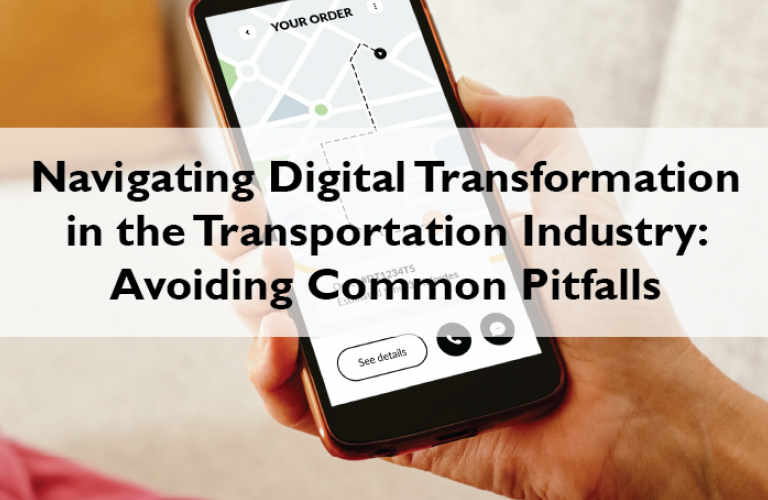
In the fast-evolving landscape of the transportation industry, digital transformation has emerged as a major trend in 2024. According to PARCEL, "research indicates consumers are making tracking requests an average of eight times during the order-to-delivery cycle. So, having the right technology to track orders is essential for" meeting customers' expectations for order-to-delivery visibility. Automation and systems integration promise increased efficiency, streamlined operations, and enhanced overall performance. However, amid the enthusiasm for adopting cutting-edge technologies, it's crucial for industry players to be mindful of potential pitfalls and common mistakes that can arise during the process of digital transformation.
Overlooking the Human Element:
One common mistake in digital transformation is focusing solely on technology and neglecting the human element. The success of automation relies heavily on the collaboration between technology and human expertise. Ensuring that employees are adequately trained and involved in the transition is paramount. Ignoring the human factor can lead to resistance, reduced productivity, and even project failure.
Inadequate Cybersecurity Measures:
As transportation systems become increasingly connected, the risk of cyber threats rises. In the rush to implement digital solutions, companies may overlook robust cybersecurity measures. Protecting confidential data, ensuring the integrity of systems, and safeguarding against cyberattacks should be at the forefront of any digital transformation strategy. Neglecting cybersecurity can expose the transportation industry to severe vulnerabilities.
Lack of Standardization and Interoperability:
With multiple technologies and systems being integrated, the lack of standardization can hinder interoperability. Incompatible systems may result in data silos and communication breakdowns, defeating the purpose of digital transformation. Industry-wide standardization and a focus on interoperability are crucial to achieving a seamless and efficient digital ecosystem.
Inadequate Planning and Scalability:
Rushing into digital transformation without a comprehensive plan can lead to inefficiencies and costly mistakes. Companies may fail to consider scalability, leading to systems that struggle to accommodate future growth. A well-thought-out strategy that considers long-term goals and scalability is essential to avoid the need for frequent updates and overhauls.
Ignoring Regulatory Compliance:
The transportation industry must adhere to numerous regulations, and digital transformation must align with these regulatory frameworks. Failing to consider compliance requirements can result in legal issues, fines, and reputational damage. A thorough understanding of the regulations is crucial for a successful and compliant digital transformation.
Neglecting User Experience:
The end-users, whether they are employees or customers, play a vital role in the success of digital transformation. Neglecting the user experience can lead to resistance and decreased adoption rates. A user-friendly interface, adequate training programs, and ongoing support are essential elements to ensure a smooth transition and optimal utilization of new technologies.
Underestimating Data Management:
The transportation industry generates vast amounts of data, and effective data management is often underestimated. Without a robust data management strategy, companies may struggle to derive meaningful insights from the collected data. Ensuring data accuracy, security, and compliance should be integral to the digital transformation process.
Neglecting Physical Infrastructure and Components:
Amid the excitement of digital transformation, overlooking the physical elements required for implementation can be a significant pitfall. Selecting the right Transportation Management System (TMS) is crucial for seamless operations. The TMS serves as the backbone of digital transformation, coordinating various elements like route optimization, load planning, and real-time tracking.
In addition to the TMS, the importance of barcode labels barcode labels cannot be understated. This seemingly simple component plays a critical role in data accuracy, inventory management, and overall efficiency. Failing to carefully select and integrate the appropriate barcode and labeling systems can lead to errors, delays, and disruptions in the supply chain.
Furthermore, consideration should be given to the physical infrastructure needed to support digital advancements. This includes the necessary hardware, such as sensors and RFID devices, to capture real-time data. The absence of a well-planned physical infrastructure can hinder the smooth functioning of the digital systems and compromise the effectiveness of the overall transformation.
Companies should invest time and resources in thoroughly assessing and selecting the right partners and physical components that align with the digital strategy. A holistic approach that integrates both digital and physical elements ensures a comprehensive and successful digital transformation in the transportation industry.
While automation and systems integration present significant opportunities for the transportation industry, avoiding common pitfalls is essential for a successful digital transformation. By prioritizing the human element, implementing strong cybersecurity measures, promoting standardization, planning for scalability, ensuring regulatory compliance, focusing on user experience, and prioritizing effective data management, the transportation industry can navigate the complexities of digital transformation and embrace a more efficient and connected future.

